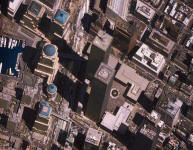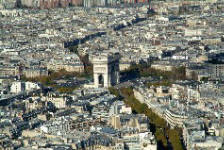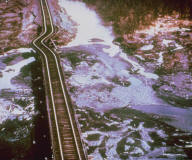|
1. The basis for categorizing the spatial arts
There is no art that is only slightly more spatial than film. When we reenter the arts, after having passed through the everyday reality at the middle of the spectrum, the proportion of space to time has shifted decisively and is in favor of space. Dividing the spatial arts on the basis of our experience of space and time results in a division which only partially runs parallel to the traditional names of painting, sculpture, and architecture. On the one hand we can be in the presence of a space from which we are excluded as we were in film. This is often but not always the case with paintings and photographs, nor is it limited to paintings and photographs. We can also be in the same space as the work, both of us being in the everyday space. This is often but not always the case with sculpture, nor is it limited to sculpture. Lastly, we can be in the same space as the work, but this in a space other than the everyday space. This is often but not always the case with architecture, nor is it limited to architecture.
2. General differences between spatial and temporal arts
The order in which we experience a temporal work of art is inherent in the work and is synonymous with its structure. The order in which we experience a spatial work is primarily determined by ourselves; it may or may not respond to the work’s structure (which is unaffected by our choice of order). What is true of the order is true too for the amount of time spent with any particular part of the work.
The spatial work of art is experienced only after it is created, when it already is. The temporal work of art is experienced only as it is re-created, as it becomes. Spatial arts achieve freedom from time; temporal arts achieve freedom within time.
Temporal arts are re-created in time in our presence through a performance. The only analogous act having to do with a spatial work is the actions taken by the creator to create the work. By definition this performance is over by the time we experience the work., though a faint echo of the performer is left inside ourselves as we choose the order in which to experience the work. A temporal work must be re-created over and over. A spatial work is created once.
A temporal work is bounded by time: it has a beginning and an ending. A spatial work is bounded by space but has no “beginning” or “ending” in space (there is no unique direction to space) and is never “over”. In a temporal work, there is no spatial presence or spatial entity that may be said to be the equivalent of the work itself (the dancer is not the dance; the scenery is not the play). The special presence of a spatial work is itself the work (though this is least so with painting, which lies nearest on the spectrum to the temporal arts). A temporal work leaves behind it a spatial residue in the form of a book or a score; the spatial work leaves itself behind in space.
3. The ways in which time still functions in the spatial arts
How we come to know something in space is temporal in nature. Without a map, a first-time visitor to a city wanders about without having a clear notion of where one place is relative to another.
Eventually time has brought him enough experience that he begins to have a clearer sense of the relative positions of the places that he has been, and of the common space which embraces them all.
While the flow of time is relatively still inside the work of spatial art, the flow of our time continues onwards unabated. Since a spatial work is finite in space, eventually our attention will return to the same place in the work. As the eye is drawn back again and again, these echoes in time bring about a resonance to that part of space.
If we watch an artist beginning a painting, we have a vivid sense of time. We see a first brush stroke appear on a blank canvas, then a second, and a third. As more and more space becomes occupied, if we do not see the hand of the painter, it becomes harder and harder to notice the appearance of the newest brush stroke, let along single out the second newest stroke, the third newest, etc.. As the last brush stroke is applied, all order in time is locked in the matrix of space, and so vanishes. At this point the experiencer of the work of art arrives, and an inverse process is begun, by which the observer in his time unravels what space has stored up during the artist’s creative time.
The fact that time no longer flows within the work affords a certain opportunity. In the temporal work the current moment has as its immediate cause the previous moment. Though we have lived through that moment we experienced it but fleetingly. With the spatial work of art we can “take” time to consider how time may have brought about the moment now frozen before us. Because we have not experienced this process, we are free to imagine any process that could plausibly account for what we now see. We can imagine a process by which forms gradually take shape and lock together in space. This past can be a long time ago, or it can have just happened, the embers of creation still hot. As they cool, we can pause to appreciate how the form is put together. We can do this for as long as we wish because there is no danger that the form will come apart again or change, though in our imagination we can imagine a future tense in which the bonds holding the form together break apart and release their energy. Indeed creation and destruction are identical but for the direction of time, and past and future can mirror each other with respect to the present. Once things have been put together, and are locked statically in space, the only way left to dynamically understand how they got to be this way is to take them apart. Thus while to one viewer a spatial work of art may appear a timeless stasis, draining the flow of time out of the observer, with no past or future of its own, to another the work may represent a moment held tenuously out of the flow of time, in between motion in time that has just now stopped, and motion in time just about to begin again, both felt to be very close.
We can imagine what would happen if time began to flow once again within the spatial work. The forms in a painting might flow and swirl, merge and separate, in other words the painting would become animation. A fully animated sculpture, moving in space would become a dancer. What would architecture become if, independently of our own motion (and the resulting changes in form due to perspective), the work changed its own spatial properties as time passed?
Rooms might constantly change shape, passageways open that were not there before as others closed up. The technology does not yet exist to do this, but philosophically, that should not limit our speculating about a new art, “flowing architecture”, that could occupy a new position on the spectrum.
All such speculations are open to the temporally disposed viewer of a spatial work of art.
Adding touch to sight is another way of adding time to our experience of a spatial work of art. Touch, unlike sight, can literally get around certain limitations of perspective. We can surround an object and hold it in our embrace. The sensations of touch can be actual or ideated. Touch is an active sense. We probe, we change pressure. So many sense receptors are involved that it would be impossible for the overall sensation to remain constant in time. When exploring an object we can feel as if we are molding its form rather than passively sensing a form that is already there. Perspective seems to tell us that our hand, held up near to our eyes, is larger than the building lying farther off. So in our imagination, with a wave of our arm we can scoop out the interior spaces of a building or create the contour of a landscape.
A static diagonal line turns into a moving line if we sequentially reveal only a part of it at a time. A similar process allows the lines of a letter V to appear as if they are in the process of approaching or receding from each other. When we move relative to an object we may forget that it is we who are in motion and attribute the motion to the object. By moving around a sculpture, we can cause two parts to seem to approach each other or recede from each other.
There is
an aesthetic as well as a quantifiable sense of proportion between two
spaces of different size that derives from an intuitive sense of how one
space would have to grow or contract in order to be equal with the
other. More will be said about the specific role time in each of
the spatial arts in the next three chapters.
"Download full text of chapter"
|








